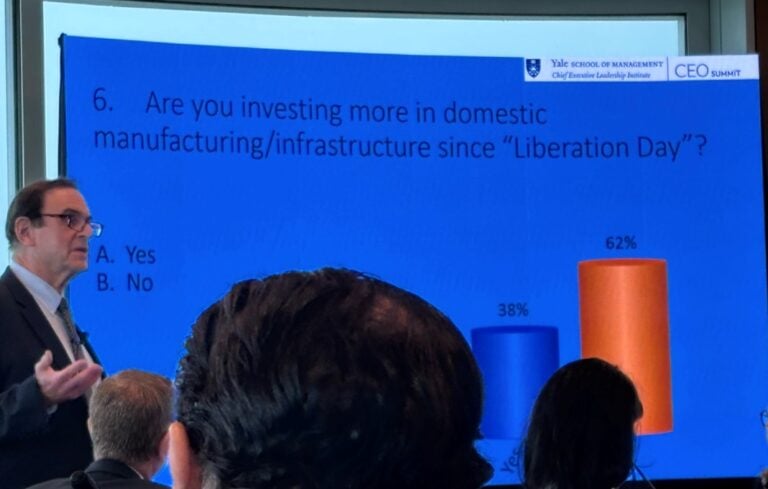
Scientists and engineers aren’t just integral to a company’s R&D efforts. They can boost productivity in other areas, too, according to a growing body of research.
At the most basic level, STEM (science, technology, engineering and mathematics) workers are trained to understand how things work, presumably helping companies introduce new technologies to the rank and file during digital transformations.
They also are encouraged to think critically, considering alternative sources of variation that could disprove well-meaning but wayward strategy or product development decisions.
The broader usefulness of STEM workers was recently put to the test by researchers from Harvard, the U.S. Census Bureau and Norway’s Institute for Social Research.
“A plausible interpretation of the results is that scientists and engineers help implement the adoption of new technologies and products at workplaces.”
Among their joint findings, published last month by the National Bureau of Economic Research, were that manufacturing firms with scientists and engineers comprising 10% of their non-R&D workforce were 4.4% more productive than companies with no such employees.
“A plausible interpretation of the results is that scientists and engineers help implement the adoption of new technologies and products at workplaces,” the study’s authors concluded.
The findings chime with the results of a study conducted last year by researchers at Cleveland’s Cape Western Reserve University and New Orleans’s Tulane University. After interviewing and surveying executives in the automotive industry, they concluded that engineers outside of formal R&D roles found ways to lower costs and develop new products, often while working with customers or production staff.
“The people doing the work often don’t recognize their efforts as innovation, but rather as low-tech tinkering,” the study’s authors said. “Nonetheless, they contribute solutions that improve products and processes throughout the industry, creating significant value for their companies and their customers.”
About 80% of industrial scientists and engineers work outside of formal R&D activities, though that doesn’t mean finding the good ones will be easy.
There remains a degree of conjecture as to whether America is suffering from a STEM crisis or a STEM surplus and a recent study by the U.S. Bureau of Labor Statistics found a bit of both is occurring.
In the academic job market, for instance, it identified signs of a surplus of Ph.Ds jockeying for faculty positions in many disciplines. But in the private sector it observed a shortage of software developers, petroleum engineers, data scientists and those in skilled trades.
There was, however, an abundant supply of biomedical, chemistry, and physics Ph.Ds, while shortages of electrical engineers were more transient than long-lasting–potentially giving hiring managers plenty of talent to pick over.




Chief Executive Group exists to improve the performance of U.S. CEOs, senior executives and public-company directors, helping you grow your companies, build your communities and strengthen society. Learn more at chiefexecutivegroup.com.
0

1:00 - 5:00 pm
Over 70% of Executives Surveyed Agree: Many Strategic Planning Efforts Lack Systematic Approach Tips for Enhancing Your Strategic Planning Process
Executives expressed frustration with their current strategic planning process. Issues include:
Steve Rutan and Denise Harrison have put together an afternoon workshop that will provide the tools you need to address these concerns. They have worked with hundreds of executives to develop a systematic approach that will enable your team to make better decisions during strategic planning. Steve and Denise will walk you through exercises for prioritizing your lists and steps that will reset and reinvigorate your process. This will be a hands-on workshop that will enable you to think about your business as you use the tools that are being presented. If you are ready for a Strategic Planning tune-up, select this workshop in your registration form. The additional fee of $695 will be added to your total.

2:00 - 5:00 pm
Female leaders face the same issues all leaders do, but they often face additional challenges too. In this peer session, we will facilitate a discussion of best practices and how to overcome common barriers to help women leaders be more effective within and outside their organizations.
Limited space available.

10:30 - 5:00 pm
General’s Retreat at Hermitage Golf Course
Sponsored by UBS
General’s Retreat, built in 1986 with architect Gary Roger Baird, has been voted the “Best Golf Course in Nashville” and is a “must play” when visiting the Nashville, Tennessee area. With the beautiful setting along the Cumberland River, golfers of all capabilities will thoroughly enjoy the golf, scenery and hospitality.
The golf outing fee includes transportation to and from the hotel, greens/cart fees, use of practice facilities, and boxed lunch. The bus will leave the hotel at 10:30 am for a noon shotgun start and return to the hotel after the cocktail reception following the completion of the round.